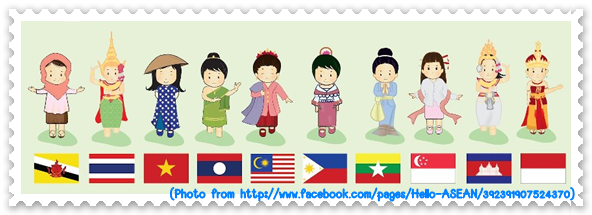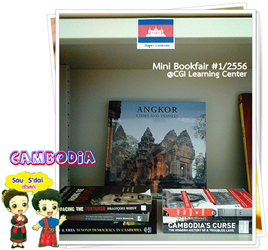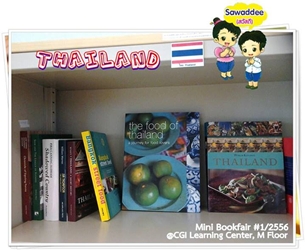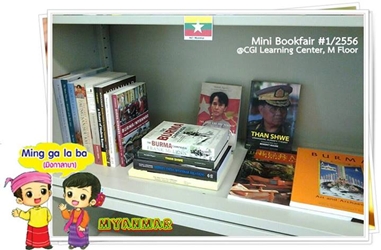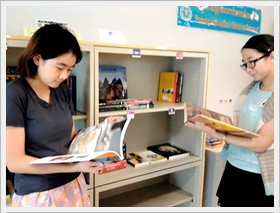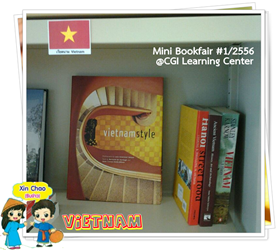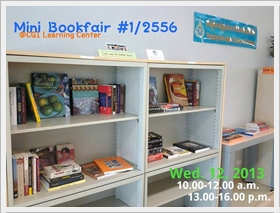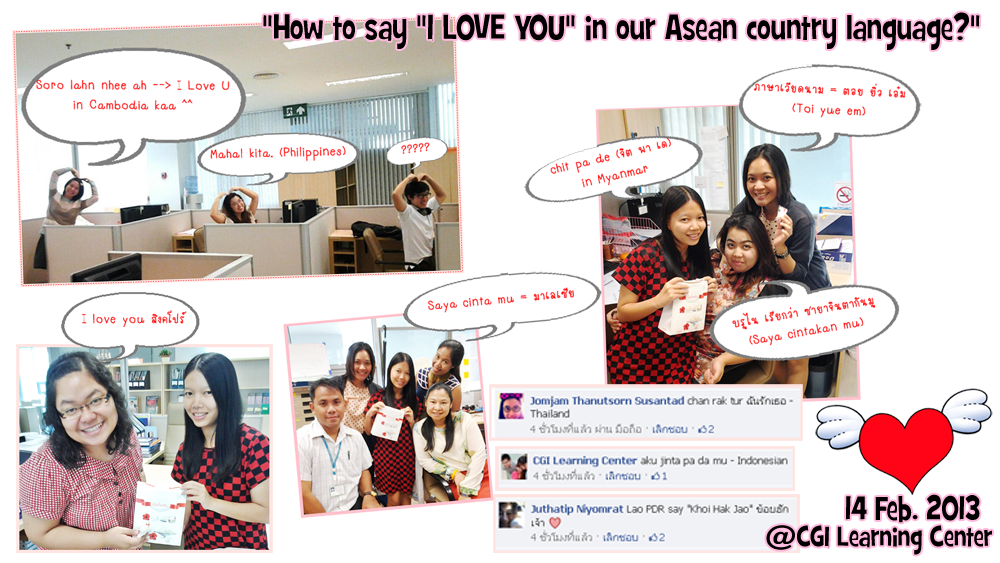ASEAN Countries
1. Brunei Darussalam 2. Cambodia 3. Indonesia 4. Lao PDR 5. Malaysia 6. Myanmar 7. Philippines 8. Singapore 9. Thailand 10. Viet Nam
It’s the “Talk of the Town” now that 10 ASEAN countries are getting ready to unionize and to join as a regional community in 2015.
CGI Learning Center is happy to bring some useful information and links to you all.
This page provides who’s who in terms of which countries have committed to be “ASEAN.
And, some information about CGI role in higher education development for ASEAN graduate study and cooperation can be found from this page.
Also, this page will continue to collect resources and more activities happened in ASEAN world for you to discover and enjoy!
Rating your knowledge on ASEAN!
This clip will let you know how well you know ASEAN.
Chulabhorn Graduate Institute – ASEAN Foundation Joint Post-graduate Scholarship Program in Science and Technology (for Academic Year 2013)
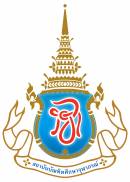 |
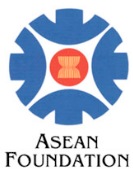 |
|||||
| (Photo From http://www.aseanfoundation.org/) | ||||||
|
Chulabhorn Graduate Institute (CGI) and the ASEAN Foundation (AF) have entered into an agreement to develop highly qualified human resources in the area of science and technology within ASEAN member countries through the Chulabhorn Graduate Institute – ASEAN Foundation Post-Graduate Scholarship Program in Science and Technology. The ASEAN Foundation, an initiative of the Leaders of the Association of Southeast Asian Nations (ASEAN), was established on 15 December 1997 to help bring about shared prosperity and a sustainable future for the peoples of all ASEAN countries. It has been mandated to promote greater awareness of ASEAN and greater interaction among its peoples and their increased participation in ASEAN activities as well as to undertake development cooperation activities that enhance mutual assistance, address equitable economic development and reduce poverty. In a year 2012, 7 (seven) scholarships were available for ASEAN nationals (except Thai citizen) who are interested to pursue a Master Degree at the CGI. Selection of successful applicants will be based on merit. |

Chulabhorn Graduate Institute has held a discussion on Vision of man power development in sciences and technology to the ASEAN community on December 17, 2012, 2nd floor of the CGI
building. The discussion was joined by Professor Dr.Somsak Ruchirawat, the Rector of CGI
, Assoc Prof. Dr.Jutamaad Satayavivad, the vice rector of CGI
, Assoc. Prof. Dr.Thanuttkhul Mongkolaussavarat, Assistant Rector of CGI and Assoc. Prof. Dr.Piniti Ratananukul.
The aim of this discussion was to examine ways to publicize the introduction of programs and courses at CGI
, and the various career paths in leading research institutes both private and public sectors in domestic and international organizations when students graduate from Chulabhorn Graduate Institute. In addition, thought was given to the way to develop the country in science and technology, which is the important fundamental to advance the progress of the country in economic aspects, as well as ways for students to exchange educational experiences whilst studying at Chulabhorn Graduate Institute. On this occasion, Miss Kornsuma Jiamsanoi and Mr.Suebsakul Pandee from Royal Thai Army Radio and Television Channel 5 had the joint role of master of ceremonies.
(Information as of 21 March 2013, Vision of manpower development in sciences and technology to the ASEAN community.)
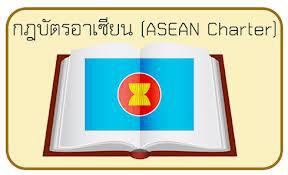
(Photo From http://www.facebook.com/pages/Hello-ASEAN/392391907524370)
The ASEAN Charter entered into force on 15 December 2008. A gathering of the ASEAN Foreign Ministers was held at the ASEAN Secretariat in Jakarta to mark this very historic occasion for ASEAN.
With the entry into force of the ASEAN Charter, ASEAN will henceforth operate under a new legal framework and establish a number of new organs to boost its community-building process.
In effect, the ASEAN Charter has become a legally binding agreement among the 10 ASEAN Member States. It will also be registered with the Secretariat of the United Nations, pursuant to Article 102, Paragraph 1 of the Charter of the United Nations.
กฎบัตรอาเซียน เปรียบเสมือนรัฐธรรมนูญของอาเซียนที่จะทำให้อาเซียนมีสถานะเป็นนิติบุคคล เป็นการวางกรอบทางกฎหมายและโครงสร้างองค์กรให้กับอาเซียน โดยนอกจากจะประมวลสิ่งที่ถือเป็นค่านิยม หลักการ และแนวปฏิบัติในอดีตของอาเซียนมาประกอบกันเป็นข้อปฏิบัติอย่างเป็นทางการของประเทศสมาชิกแล้ว ยังมีการปรับปรุงแก้ไขและสร้างกลไกใหม่ขึ้น พร้อมกำหนดขอบเขตหน้าที่ความรับผิดชอบขององค์กรที่สำคัญในอาเชียนตลอดจนความสัมพันธ์ในการดำเนินงานขององค์กรเหล่านี้ ให้สอดคล้องกับความเปลี่ยนแปลงในโลกปัจจุบัน เพื่อเพิ่มประสิทธิภาพของอาเซียนให้สามารถดำเนินการบรรลุตามวัตถุประสงค์และเป้าหมายโดยเฉพาะอย่างยิ่งการขับเคลื่อนการรวมตัวของประชาคมอาเซียน ให้ได้ภายในปี พ.ศ.2558 ตามที่ผู้นำอาเซียนได้ตกลงกันไว้
(Ref. http://goo.gl/gDUaA)
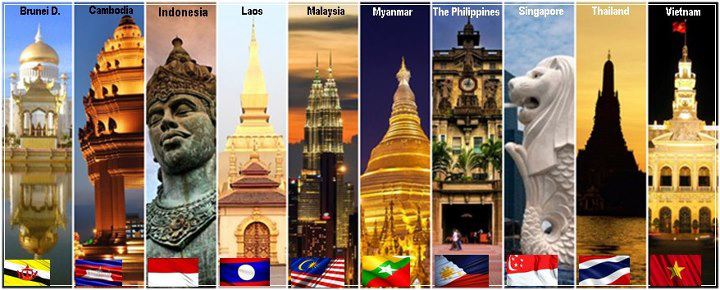
(Photo From http://www.facebook.com/HelloAseanity)
The Association of Southeast Asian Nations, or ASEAN was established on 8 August 1967 in Bangkok, Thailand, with the signing of the ASEAN Declaration (Bangkok Declaration) by the Founding Fathers of ASEAN, namely Indonesia, Malaysia, Philippines, Singapore and Thailand. Brunei Darussalam then joined on 7 January 1984, Viet Nam on 28 July 1995, Lao PDR and Myanmar on 23 July 1997, and Cambodia on 30 April 1999, making up what is today the ten Member States of ASEAN. The ASEAN Community is comprised of three pillars, the ASEAN Political-Security Community, ASEAN Economic Community and ASEAN Socio-Cultural Community.
Ref: http://www.asean.org/asean/about-asean/overview, Britannica Encyclopedia Online, Wikipedia the Free Encyclopedia.
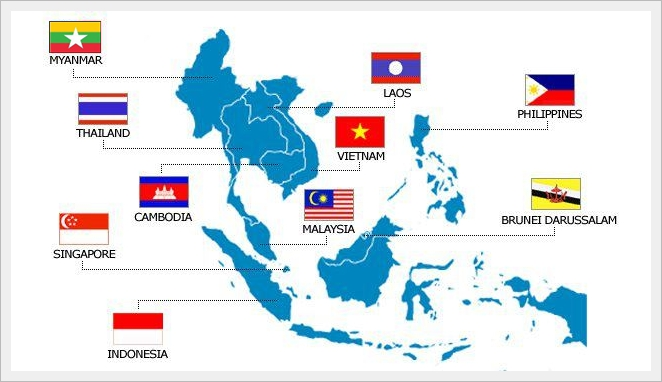 |
ASEAN Member States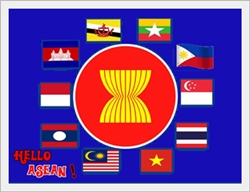 1. Brunei Darussalam 2. Cambodia 3. Indonesia 4. Lao PDR 5. Malaysia 6. Myanmar 7. Philippines 8. Singapore 9. Thailand 10. Viet Nam (Credit Photo Hello Asean) |
ASEAN Political – Security Community To build on what has been constructed over the years in the field of political and security cooperation, the ASEAN Leaders have agreed to establish the ASEAN Political-Security Community (APSC). The APSC shall aim to ensure that countries in the region live at peace with one another and with the world in a just, democratic and harmonious environment.
The members of the Community pledge to rely exclusively on peaceful processes in the settlement of intra-regional differences and regard their security as fundamentally linked to one another and bound by geographic location, common vision and objectives. It has the following components: political development; shaping and sharing of norms; conflict prevention; conflict resolution; post-conflict peace building; and implementing mechanisms.
The APSC Blueprint envisages ASEAN to be a rules-based Community of shared values and norms; a cohesive, peaceful, stable and resilient region with shared responsibility for comprehensive security; as well as a dynamic and outward-looking region in an increasingly integrated and interdependent world. The APSC Blueprint is guided by the ASEAN Charter and the principles and purposes contained therein. It provides a roadmap and timetable to establish the APSC by 2015. It also leaves room for flexibility to continue programmes/activities beyond 2015 in order to retain its significance and have an enduring quality.
Ref. http://www.asean.org/communities/asean-political-security-community
ASEAN Economic Community The ASEAN Economic Community (AEC) shall be the goal of regional economic integration by 2015. AEC envisages the following key characteristics: (a) a single market and production base, (b) a highly competitive economic region, © a region of equitable economic development, and (d) a region fully integrated into the global economy.
The AEC areas of cooperation include human resources development and capacity building; recognition of professional qualifications; closer consultation on macroeconomic and financial policies; trade financing measures; enhanced infrastructure and communications connectivity; development of electronic transactions through e-ASEAN; integrating industries across the region to promote regional sourcing; and enhancing private sector involvement for the building of the AEC. In short, the AEC will transform ASEAN into a region with free movement of goods, services, investment, skilled labour, and freer flow of capital.
ASEAN Economic Community (AEC) Blueprint The ASEAN Leaders adopted the ASEAN Economic Blueprint at the 13th ASEAN Summit on 20 November 2007 in Singapore to serve as a coherent master plan guiding the establishment of the ASEAN Economic Community 2015.
Ref. http://www.asean.org/communities/asean-economic-community
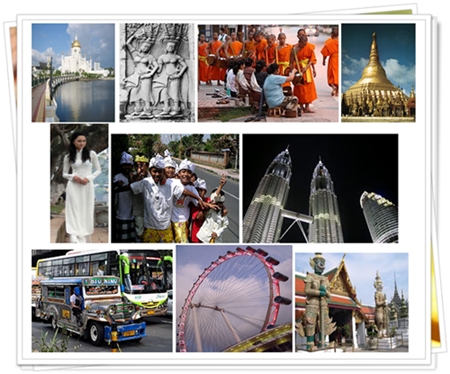 |
ASEAN Socio-Cultural Community – ASEAN Socio – Cultural The ASEAN Socio-Cultural Community aims to contribute to realising an ASEAN Community that is people-oriented and socially responsible with a view to achieving enduring solidarity and unity among the peoples and Member States of ASEAN. It seeks to forge a common identity and build a caring and sharing society which is inclusive and where the well-being, livelihood, and welfare of the peoples are enhanced. ASCC is focused on nurturing the human, cultural and natural resources for sustained development in a harmonious and people-oriented ASEAN. – ASEAN Socio-Cultural Community (ASCC) Blueprint The ASCC Blueprint represents the human dimension of ASEAN cooperation and upholds ASEAN commitment to address the region’s aspiration to lift the quality of life of its peoples. The goals of the ASCC are envisaged to be achieved by implementing concrete and productive actions that are people-centred and socially responsible. This set of cooperative activities has been developed based on the assumption that the three pillars of the ASEAN Community are interdependent and interrelated and that linkages are imperative to ensure complementarity and unity of purpose. The ASCC Blueprint was adopted by the ASEAN Leaders at the 14th ASEAN Summit on 1 March 2009 in Cha-am/Hua Hin, Thailand. Ref. http://www.asean.org/communities/asean-socio-cultural-community 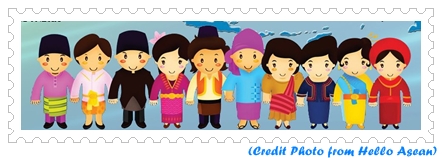 |
Social Network Asean’s Community
The Resourses in this database provides all of the informations of ASEAN’s resources include with bibliography of Books, Thesis, Researches, Articles, Documents, Websites, Television programmes are also both of TH/EN language.
(Update Resourses from http://nstda.or.th/asean/)
(Update News from http://www.asean.org/)
| “Mini Bookfair #1/2556” @CGI Learning Center, M Floor Date: June 12-14, 2013 Time: 10.00-12.00 a.m. and 13.00-16.00 p.m. With ASEANs Book |
| Main Concept The main concept of the project is to provide a space for students and faculties to create a forum to express and share knowledge and experience on ethical and social cultural activities. We provide access to multimedia and books on good practices and guides to wisdom thinking for everyone who needs to learn the intellectual values of life, and to live a valuable life, wisely. The project aims to expand and to cover a cross-cultural scope in the future. CGI Cultural and religious activities can be noted from the Institute’s concern for providing a Muslim prayer room which is in addition to the regular religious practice on occasional national events. CGI Cultural Hall Project is an initiative to encourage cultural attitude and practice as well as to preserve national cultures for our community, beginning with Thai culture and Buddhism.
Venue: CGI Learning Center on 12nd Floor, with multimedia presentation illustrating Thai Buddhist culture and book exhibition. |
Name : Mr. Mario Wibowo
Program : Chemical Biology
Degree : M.Sc.
Background : B.Sc. Agriculture Technology
Country : Indonesia
Program : Environmental Toxicology
Degree : M.Sc.
Background : B.Sc. In Dept. of Chemistry
Country : Indonesia
Name : Mrs. Retno Puji Lestari
Program : Environmental Toxicology
Degree : M.Sc.
Background : B.Sc.Chemistry
Country : Indonesia
อภิชัย อัครปรีดี
| Call no. DS527.7 อ251ม 2551
หนังสือเล่มนี้จะพาเราไปสัมผัสกับประเทศ “พม่า” หรือที่ทางการของพม่าได้เปลี่ยนชื่อประเทศเป็น “เมียนร์ม่าร์” อีกดินแดนหนึ่งที่ชวนหลงใหลในแถบเอเชีย ศึกษาเส้นทางการท่องเที่ยวที่น่าสนใจ รวมทั้งวัฒนธรรมงานประเพณี เทศกาลท่องเที่ยวที่น่าสนใจ ตลอดจนข้อมูลที่พัก การเดินทาง ของกิน ซื้อของฝาก ทุกเรื่องราวของการท่องเที่ยวได้ถูกเรียบเรียงมาแล้วอย่างดี พร้อมภาพประกอบสวยงาม ที่จะช่วยนำทางให้คุณเดินทางท่องเที่ยวได้อย่างคุ้มค่าคุ้มเวลากับคู่มือนำเที่ยวเล่มนี้ หนังสือเล่มนี้อาจทำให้คุณเปลี่ยนทัศนคติกับวิถีชีวิตและน้ำใจที่งดงามของชาวพม่าที่รอให้คุณได้ไปสัมผัสและเรียกเค้าว่า “เพื่อนบ้าน” ได้อย่างเต็มหัวใจ “มิงกลาบา พม่า : เส้นทางแบกเป้เที่ยวที่นิยมสุด ย่างกุ้ง มัณดาเลย์ พุกาม อินเล แปร พระธาตุอินทร์แขวน หงสาวดี” New Books on March, 2013 http://www.cgi.ac.th/library/services/new_books/march_2013 |
เฉลิมชัย ไชยชมภู
| Call no. TT848 พ965 2552
Book Description แพรวา ราชินีแห่งไหม หนังสือเล่มนี้จังหวัดกาฬสินธุ์จัดงานมหกรรมวิจิตรแพรวาราชินีแห่งไหม เพื่อเฉลิมพระเกียรติสมเด็จพระนางเจ้าฯพระบรมราชินีนาถ เนื่องในวันเฉลิมพระชนมพรรษา เรื่องราวของเนื้อหาบอกถึงแหล่งผลิต ความเป็นมาต้นกำเนิดของผ้าไหมแพรวา และความหมายของผ้าไหมแพรวา รวมทั้งลักษณะของผ้าไหมแพรวา วิธีการทอและการประดิษฐลาย เนื้อหาภายในหนังสือเล่มนี้มีภาษาอังกฤษประกอบ
Praewa, The Queen of Thai fabric
Praewa Silk is the specific name that northeastern people call one kind of fabric which used for cover the shoulder and used in special occasions like the festivals, traditions or religious ceremonies. In fact, the word “Praewa” is a compound word. It comes from three clauses as follow: “Fabric” means a kind of woven or felted material. It made from various kinds of fibers such as cotton, silk, jute, and flax, etc. “Prae” or “Pea” is a piece of fabric which is not made into a dress. They are various names called by the materials that are made such as Praemai (Paemai), Prae-Faiy (Pea-Faiy). “Wa” refers to kind of Thai measurement. It is 1 arm long or about 2 meter in length. Therefore, Praewa fabric is 1 arm length. New Books on March, 2013 http://www.cgi.ac.th/library/services/new_books/march_2013/th_en_books |
อำนวย วีรวรรณ
| Call no. DS568 ม192 2552
Book Description มรดกภูมิปัญญาทางวัฒนธรรม ประกอบด้วยผลงานสร้างสรรค์ทางสถาปัตยกรรม จิตรกรรม ประติมากรรม หัตถกรรม ศิลปะพื้นบ้าน ความรู้ความสามารถ ทักษะ วิถีการปฏิบัติซึ่งแสดงออกทางภาษา ศิลปะการแสดง งานช่างฝีมือ ความเชื่อ ประเพณี พิธีกรรม อาหาร เป็นต้น โดยที่สิ่งต่าง ๆ ดังกล่าว ได้ส่งผ่านและสืบทอดต่อกันมารุ่นต่อรุ่น เป็นแนวทางปฏิบัติหรือในบางเรื่องเป็นเสมือนจิตวิญญาณที่ยึดถือร่วมกันของคนในสังคม รวมทั้งในบางเรื่องยังคงมีความงดงามและมีคุณค่าทางศิลปะสูงยิ่ง เนื้อหาภายในหนังสือเล่มนี้มีภาษาอังกฤษประกอบ
Intellectual Cultural Heritage Intellectual cultural heritage encompasses the creative works of architecture, painting, sculpture, handicraft, and folk arts; the knowledge, skill and practices expressed through language, performing arts, crafts, beliefs, traditions, rites, and food, for example, which are transmitted from generation to generation as practices or approaches. In some cases, they are considered as a common spiritual bond of the people in the communities. Some intellectual cultural heritage items are beautiful and have high artistic values.
New Books on March, 2013 http://www.cgi.ac.th/library/services/new_books/march_2013/th_en_books |
สรรใจ แสงวิเชียร ; พงษ์ศรี เลขะวัฒนะ ; ประกายฉัตร สุขสวัสดิ์, มร.ว. ; Martin, William Merle
| Call no. DS525 ศ525 2554
Book Description Mekong Folk Arts and Culture Cultural arts, or a simpler term, Culture and arts, has been with mankind for a nary long time. People of every ethnic background do have arts and culture as their own outstanding identity. Human identities can denote similarities as well as differences. Key empirical evidences are cave paintings, earthen wares, ornaments, clothes, and iron tools excavated from ancient burial and residential sites.
The ASEAN membered countries have widely done research on cultural performing arts and have presented their fruitful research resuults in international seminars. (Asst. Prof. Dr. Supachai Samappito) New Books on March, 2013 http://www.cgi.ac.th/library/services/new_books/march_2013/th_en_books |
ผู้แต่ง : กรมอาเซียน กระทรวงต่างประเทศ
| Call no. DS526 .7 บ268 2552
Book Description บันทึกการเดินทางอาเซียน เป็นหนังสือที่เล่าเรื่องราวอันเป็นประโยชน์ของประเทศสมาชิกของอาเซียนทั้ง 10 ประเทศ ตั้งแต่การก่อตั้งและการพัฒนาการจนถึงการประชุมสุดยอดอาเซียนครั้งที่ 14 และครั้งที่ 15 ที่ประเทศไทยได้เป็นเจ้าภาพ
New Books on March, 2013 |
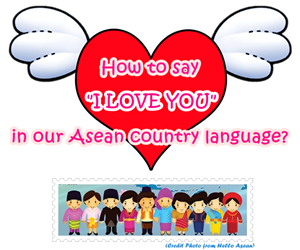 |
Valentine’s Day activity with CGI Learning Center Fanpage! Valentine’s Day activity with CGI Learning Center |

